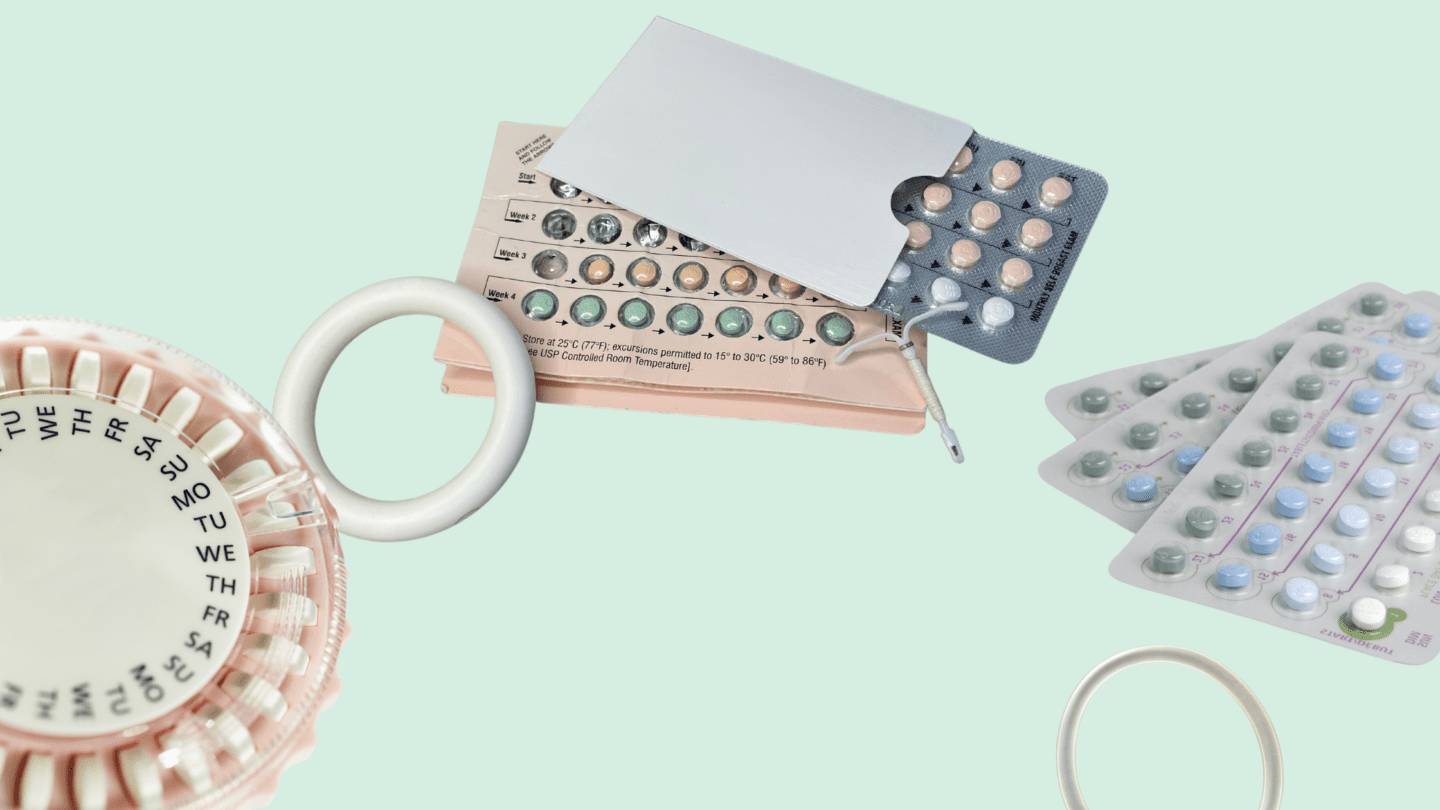If you’re on (or are considering starting), you’re already familiar with your menstrual period. But the “period” you get while you’re on some forms of isn’t actually a period, it’s called withdrawal bleeding.
The term refers to when you experience a withdrawal of hormones from your , which causes your uterine lining to shed.1 But even though withdrawal bleeding might look and feel like a period, that’s where the similarities end.2 To make things even more confusing, withdrawal bleeding is not medically necessary, and doesn’t add any major health benefits nor risks.
Some people opt to delay withdrawal bleeding by extending the amount of time they use before taking a break.3 Others are sometimes able to skip it entirely by taking continuously or using a continuous method like an IUD (though not everyone loses their period).4 For almost every type of hormonal birth control, there are different options for controlling the timing of withdrawal bleeding. So how do you choose?
Here’s everything you need to know about withdrawal bleeding, when it happens and why, and what you can do about it.
What is withdrawal bleeding?
Withdrawal bleeding occurs if you use a type of that includes a break between your regular doses of hormones. This drop in hormones causes your body to shed the mucus and lining of the , which is why withdrawal bleeding looks like a period.2 As a result, withdrawal bleeding can happen if you take a scheduled break between regular doses of any type of hormonal birth control, such as between monthly pill packs, or when you stop taking one type of when switching to another.5 Like with a period, you may also experience bloating, cramps, and other premenstrual symptoms as your body reacts to the drop in hormones.6
Which types of cause withdrawal bleeding?
Only hormonal birth controls can cause withdrawal bleeding. These include combined oral contraceptives like the pill, which involves a standard 28-day cycle: 21 days of hormones and 7 days of taking a or no pill at all.2 Other variations exist, like 24/47 and 26/28 regimens, and often involve less bleeding. The patch9 and the vaginal ring10 also involve 3 weeks of hormones, followed by a one week break.
Is adyn right for you? Take the quiz.
Anytime you take continuously without a break, like if you take the Depo-Provera injection, use a hormonal IUD, or take extended-use birth control pills, you won’t experience withdrawal bleeding. With these contraceptives, you are more likely to get some unscheduled bleeding, called , though. can decrease over time as your body adjusts to the , but that doesn’t happen for everyone.3
You also won’t experience withdrawal bleeding from the copper IUD because it isn’t a hormonal contraceptive – you get a regular period.11
How is withdrawal bleeding different from a period?
The hormones from your prevent your from thickening during your cycle and can also prevent you from ovulating. This means that there’s less build-up to get rid of, and so bleeding is usually lighter and shorter than a regular period.2
Because regulates your hormones, premenstrual symptoms are often less severe than during a regular period, too.12 This is why many people choose to take to help with their PMS or PMDD.
When does withdrawal bleeding happen and how long does it last?
How and when withdrawal bleeding occurs varies from person to person and can change depending on how you react to different types of . One study found that it’s common to have less or shorter withdrawal bleeding and less severe premenstrual symptoms using 24/4 and 26/2 regimens than 21/7 options.13
You’re likely to start having withdrawal bleeding during the first few days of your break week and have it last 4-6 days.6 If you take the pill and forget a day or two, you might also have some slight withdrawal bleeding due to the temporary drop in hormones. And if you stop entirely, you won’t be protected from pregnancy, but you might experience withdrawal bleeding before your regular cycle kicks in again.14 So, whenever you take a break from hormonal birth control, whether it’s temporary or long-term, experiencing withdrawal bleeding is totally normal.
How long withdrawal bleeding lasts can also decrease the longer you’re on . In a study that compared new and current users of 21/7 day regimen birth control pills, people who just started taking had slightly more bleeding in their 2nd cycle compared to those already taking at the start of the study.6 But by the third cycle, bleeding flow in new users decreased and was similar between both groups. By nine months, women taking continuous had less overall than those on the 21/7 day regimen.
Keeping track of the duration of your withdrawal bleeding can be a helpful tool for monitoring changes to your health.
Keeping track of the duration of your withdrawal bleeding can be a helpful tool for monitoring changes to your health. With time, you can figure out whether your monthly bleeding is decreasing over time and whether this is a regular pattern for you. If bleeding is heavy or interferes with your daily life, you should talk to your doctor about possibly switching to a different type of .
What is the purpose of withdrawal bleeding?
Medically, there is no purpose for withdrawal bleeding! Birth control pill regimens were originally designed to mimic a natural cycle — although many people do not naturally experience a 28 day cycle — with the “period” included to reassure them that their was working to prevent pregnancy.2 Since withdrawal bleeding doesn’t occur if you become pregnant (more on that later), a scheduled break in administered hormones was a useful check before the invention of rapid home pregnancy tests.
But today we know birth control pills are highly effective at preventing pregnancies. And since prevents ovulation and build-up of the uterine lining, there’s no biological need for an off week. So why do so many birth control pills still come with s?
Well, there are some benefits of withdrawal bleeding. One is just peace of mind. Because you won’t see any withdrawal bleeding if you’re pregnant, some people find that having a monthly check-in can be a big relief.3 But if you think you skipped any doses or haven’t been taking it as prescribed,15 and there’s a chance you might be pregnant, it’s a good idea to take a pregnancy test or consult with your doctor if you miss your withdrawal bleeding “period.”
If you’ve been taking your consistently and correctly, and miss a withdrawal bleed, it’s highly unlikely that you’re pregnant. But if you’re concerned, you may want to take a pregnancy test for reassurance, especially during their first year of taking .16,3
Like what you’re reading? Get the latest straight to your inbox 💌
Another benefit from taking a break (and allowing the withdrawal bleed to happen) is that it can help stave off in your next cycle.17-18 You can talk to your doctor about figuring out the right way to schedule a break from your hormones that both treats unpleasant side effects from while ensuring it remains effective.19
And if you’re worried about whether keeping withdrawal bleeding in your schedule comes with any health risks, the answer is a resounding no. You can still have sex during your week just as you would at any other point in your cycle. Since you don’t ovulate on hormonal birth control, you’re still protected from pregnancy even during a break in taking hormones.20
Long story short, since withdrawal bleeding doesn’t come with any health benefits or risks, you’re free to choose the regimen that works best for your body and lifestyle.
What if I want to delay or stop bleeding altogether?
If you’re interested in having fewer periods, there’s good news. It’s safe and there are several options available for how to do it.
Continuous involves taking active hormones all year long with no breaks.14 This means there’s no scheduled withdrawal bleeding, but many people experience that usually gets better over time.21 Continuous options include replacing each weekly vaginal ring or patch without taking a week off, taking birth control pills continuously, or using hormonal IUDs or the Depo-Provera injection.
Extended entails taking your regular for longer than 21 days, but involves taking breaks throughout the year. Similar to your options for continuous use , you can replace your regular weekly vaginal ring or patch immediately for consecutive weeks, or take birth control pills for more than a month in a row.
There are several pills available that have standardized regimens and involve taking different combinations of hormones for 3 or 4 months, in which you’ll experience withdrawal bleeding four times a year.14 Other options include taking pills that have the same dose of hormones every day and simply skipping the week off by starting the next pack right away.
What are the benefits of skipping withdrawal bleeding?
Fewer periods often means less discomfort, fewer out-of-pocket expenses on period supplies, and greater control over your life, especially if you have irregular cycles.2
In a 2003 study that compared 32 women given either 28-day (21/7) cycle or continuous use of /levonorgestrel , continuous users reported significantly less bloating and fewer menstrual cramps.22
Being able to manage your cycle can also allow you to plan ahead for events when withdrawal bleeding might be inconvenient, like a wedding, running a marathon, or a beach vacation.
Taking control of your cycle
If you take hormonal birth control, you’ll likely experience withdrawal bleeding whenever you take a break from hormones, whether that’s at the end of a 28- or 91-day cycle. Your protects you during this time as long as you take it as prescribed, and it can help you know that you’re not pregnant.
But if you’re interested in changing the duration of withdrawal bleeding or if bleeding seems excessive, there are many options you can try while still preventing pregnancy. Depending on your preference, you can reschedule withdrawal bleeding or skip it altogether, no matter if it’s for a one-time event or because you’re looking for a more permanent change.
Your doctor may not bring up these options right away, especially if they’re more familiar with the standard 21/7 day cycle1, so be sure to ask questions during your doctor’s visit to find the right type of that works for you.
-
- Mayo Clinic Staff. “Delaying your period with hormonal birth control.” (2022 Jan 28). Last accessed 2022 Feb 03.
- Nelson, Anita L. “Extended-Cycle Oral Contraception.” Treatments in Endocrinology 4.3 (2005): 139-145.
- Miller, Leslie, and James P. Hughes. “Continuous combination oral contraceptive pills to eliminate withdrawal bleeding: a randomized trial.” Obstetrics & Gynecology 101.4 (2003): 653-661.
- Planned Parenthood. “What’s an IUD insertion like?” (N.D.): Last accessed 2022 Feb 16.
- Lesnewski, Ruth, Linda Prine, and Regina Ginzburg. “Preventing gaps when switching contraceptives.” American Family Physician 83.5 (2011): 567-570.
- Sulak, Patricia J., et al. “Acceptance of altering the standard 21-day/7-day oral contraceptive regimen to delay menses and reduce hormone withdrawal symptoms.” American Journal of Obstetrics and Gynecology 186.6 (2002): 1142-1149.
- Anttila, Leena, et al. “Cycle Control and Bleeding Pattern of a 24/4 Regimen of Drospirenone 3 mg/Ethinylestradiol 20 μg Compared with a 21/7 Regimen of Desogestrel 150 μg/Ethinylestradiol 20 μg.“ Clinical Drug Investigation 31.8 (2011): 519-525.
- Mappi, Rossella E., Marco Serrani, and Jeffrey T. Jensen. “Noncontraceptive benefits of the estradiol valerate/dienogest combined oral contraceptive: a review of the literature.” International Journal of Women’s Health 6 (2014): 711.
- Mayo Clinic Staff. “Birth control patch.” (2021 Aug 06): Last accessed 2022 Feb 16.
- Mayo Clinic Staff. “Vaginal ring.” (2020 Feb 12): Last accessed 2022 Feb 16.
- FDA. “Drug label: Paragard.” (N.D.): Last accessed 2022 Feb 18.
- Lete, Iñaki, and Oihane Lapuente. “Contraceptive options for women with premenstrual dysphoric disorder: current insights and a narrative review.” Open Access Journal of Contraception 7 (2016): 117.
- Graziottin, Alessandra. “The shorter, the better: A review of the evidence for a shorter contraceptive hormone-free interval.” The European Journal of Contraception & Reproductive Health Care 21.2 (2016): 93-105. [pdf provided]
- Mayo Clinic Staff. “Birth control pill FAQ: Benefits, risks and choices.” (2021 Jun 12): Last accessed 2022 Feb 16.
- Planned Parenthood. “Are birth control pills effective?” (N.D.): Last accessed 2022 Feb 07.
- Planned Parenthood. “What are the side effects of the birth control pill?” (N.D.): Last accessed 2022 Feb 07.
- Villavicencio, Jennifer, and Rebecca H. Allen. “Unscheduled bleeding and contraceptive choice: increasing satisfaction and continuation rates.” Open Access Journal of Contraception 7 (2016): 43.
- Sulak, Patricia J., et al. “Prospective analysis of occurrence and management of breakthrough bleeding during an extended oral contraceptive regimen.” American Journal of Obstetrics and Gynecology 195.4 (2006): 935-941.
- Sexual and Reproductive Health, Alberta Health Services. “Extended and Continuous Use Birth Control.” (2018 Nov 02): Last accessed 2022 Feb 03.
- Sexual and Reproductive Health, Alberta Health Services. “Birth Control Pill.” (2018 Nov 02): Last accessed 2022 Feb 07.
- French, Valerie. “What You Should Know About Breakthrough Bleeding With Birth Control.” Acog.org (2021 Jan): Last accessed 2022 Feb 07.
- Kwiecien, Marni, et al. “Bleeding patterns and patient acceptability of standard or continuous dosing regimens of a low-dose oral contraceptive: a randomized trial.” Contraception 67.1 (2003): 9-13.








